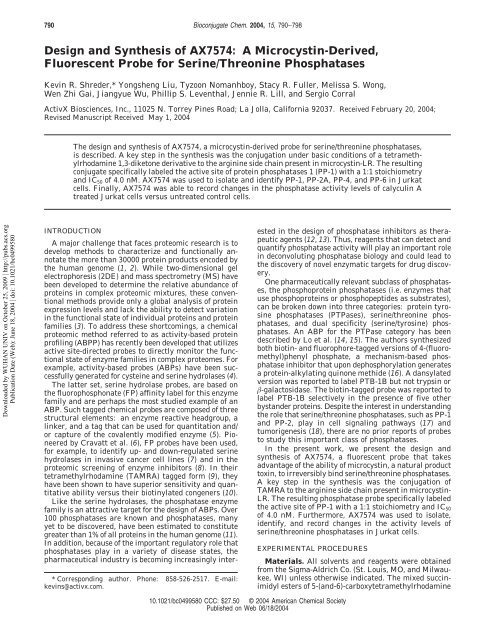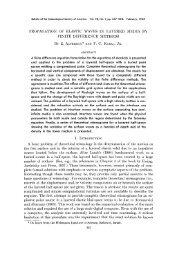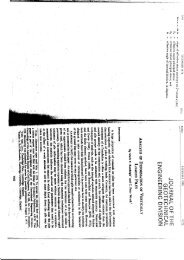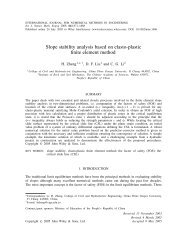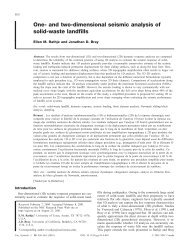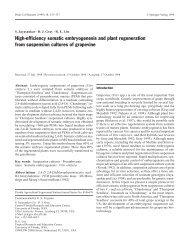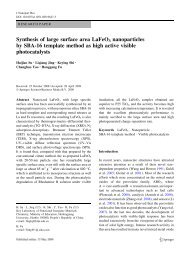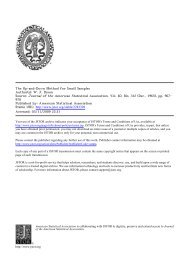Design and Synthesis of AX7574: A Microcystin-Derived ...
Design and Synthesis of AX7574: A Microcystin-Derived ...
Design and Synthesis of AX7574: A Microcystin-Derived ...
You also want an ePaper? Increase the reach of your titles
YUMPU automatically turns print PDFs into web optimized ePapers that Google loves.
794 Bioconjugate Chem., Vol. 15, No. 4, 2004 Shreder et al.Scheme 1.<strong>Synthesis</strong> <strong>of</strong> the <strong>Microcystin</strong>-TAMRA Probe <strong>AX7574</strong>Downloaded by WUHAN UNIV on October 25, 2009 | http://pubs.acs.orgPublication Date (Web): June 18, 2004 | doi: 10.1021/bc04995804,6-dioxoheptanoic acid to form a carboxylic acid bearingderivative. However, this acid was not further elaboratedupon. In the end, they chose a synthetic route in which4,6-dioxoheptanoic acid was carbodiimide coupled tocephalexin <strong>and</strong> the resulting dione conjugated to pyoverdinin 20% yield. Because microcystin modification with4,6-dioxoheptanoic acid would yield a tricarboxylic acid,any resulting amidation with an amine bearing fluorophorederivative would be difficult to accomplish selectively.Consequently, we started our approach, analogousto the case <strong>of</strong> cephalexin, with the synthesis <strong>of</strong> a fluorophore-dionederivatization reagent. In particular, wechose to use tetramethylrhodamine (TAMRA) as thefluorophore, because <strong>of</strong> its previous success as a sensitive<strong>and</strong> quantitative tag for ABPs.The requisite dione was prepared from the mixedsuccinimidyl esters <strong>of</strong> 5-(<strong>and</strong> 6)-carboxytetramethylrhodamine(TAMRA-OSu). Reaction <strong>of</strong> TAMRA-OSu with(Boc-4-aminomethyl)piperidine followed by treatment <strong>of</strong>the resulting product with 1:1 TFA/DCM produced thesecondary amine 1 (Scheme 1). When this amine wastreated with an excess <strong>of</strong> N,N′-carbonyldiimidazoleactivated4,6-dioxoheptanoic acid, compound 1 was quantitativelyconverted into the desired dione 2. Afterpurification via C 18 reverse phase HPLC, the TAMRAdione2 was isolated in 66% yield. As expected, 1 H NMRanalysis showed the presence <strong>of</strong> resonances for both theenol <strong>and</strong> dione form <strong>of</strong> compound 2. Furthermore, doubling<strong>of</strong> the enol, dione, <strong>and</strong> aromatic resonances wasobserved from the use <strong>of</strong> the mixed TAMRA isomerstarting material.The probe <strong>AX7574</strong> was produced from the condensation<strong>of</strong> compound 2 with microcystin-LR under basic conditions.<strong>Microcystin</strong>-LR (580 µg) was heated with a 10-foldexcess <strong>of</strong> dione in a mixture <strong>of</strong> 20% dioxane/1 M NaHCO 3(pH 9.0) for 2 days at 65 °C. LC/MS analysis indicatedthe consumption <strong>of</strong> microcystin-LR <strong>and</strong> the presence <strong>of</strong>a new TAMRA-containing peak (as evidenced by anabsorption at 550 nm) with the desired product mass(MALDI-FTMS (DHB): m/z 1625.8402 - C 87 H 112 N 14 O 17+ H requires 1625.8464). <strong>AX7574</strong> was isolated from otherimpurities using C 18 reverse phase chromatography in4% yield.<strong>AX7574</strong> was characterized structurally using t<strong>and</strong>emmass spectrometry. Fragmentation <strong>of</strong> the parent ion (MS/MS) resulted in two major ions, 1099.5 <strong>and</strong> 527.4. Theseions were assigned to the fragments that result from theN-CO cleavage <strong>of</strong> the tertiary amide bond found in thelinker. Further isolation <strong>and</strong> fragmentation <strong>of</strong> these ions(MS/MS/MS) were consistent with the expected structure<strong>of</strong> <strong>AX7574</strong> (see Figure 2). For the former ion, fragmentationscorresponding to cleavage <strong>of</strong> the cyclic peptidebackbone, decarbonylation, <strong>and</strong> loss <strong>of</strong> the pyrimidinemoiety were seen. For the latter ion, fragments correspondingto cleavage about the amide bond <strong>of</strong> the linker-TAMRA moiety were observed.Once the structure <strong>of</strong> <strong>AX7574</strong> was secured, attentionwas turned to demonstrating its ability to label PP-1.PP-1 (25 nM) was incubated with <strong>AX7574</strong> (0.5 µM) in 50mM HEPES, 5% DMSO, 0.01% Triton x-100, pH 7.4, atambient temperature. At various timepoints, samplealiquots were removed, quenched with DTT-containingsample buffer, <strong>and</strong> then heat-denatured. The resultingsamples were subjected to denaturing SDS-PAGE, <strong>and</strong>labeled enzyme was visualized using a flatbed laserinducedfluorescence scanner. Importantly, the TAMRAtag provided a sensitive fluorescent h<strong>and</strong>le by which thedegree <strong>of</strong> labeling could be quantified (see ExperimentalProcedures). Consistent with the results <strong>of</strong> Holmes et al.(vide supra), the kinetics <strong>of</strong> PP-1 labeling was on theorder <strong>of</strong> hours (see Figure 3) with 65% <strong>of</strong> the labelingoccurring at ∼16 h. When the time course data were fitto a single exponential, maximal labeling was determinedto approach a ratio <strong>of</strong> 1:1 PP-1 to <strong>AX7574</strong>.Several additional experiments were run to determineif the observed labeling was specific for the active site <strong>of</strong>
A <strong>Microcystin</strong>-<strong>Derived</strong> Phosphatase Probe Bioconjugate Chem., Vol. 15, No. 4, 2004 795Figure 2. Mass spectrometric (MS) structural identification <strong>of</strong> <strong>AX7574</strong>. Shown are some <strong>of</strong> the observed fragmentation patternsfrom the two major parent ions observed during the MS/MS analysis <strong>of</strong> the doubly charged parent ion peak. Dual letter fragmentmasses (vide infra) are derived from a counterclockwise trace along the cyclic peptide backbone <strong>of</strong> <strong>AX7574</strong> from the designated point<strong>of</strong> fragmentation to the next indicated point <strong>of</strong> fragmentation: ea - H 2O ) 592, ga + NH 2-H 2O ) 521, fb ) 842, fb - CO ) 814, dc) ih ) 971, gc ) ai ) 786, hc ) 703, ic ) ag ) 574, ad ) 390, af ) 503, ah ) 657, jh ) 674, hj - H 2O ) 408.Downloaded by WUHAN UNIV on October 25, 2009 | http://pubs.acs.orgPublication Date (Web): June 18, 2004 | doi: 10.1021/bc0499580Figure 3. Kinetics <strong>of</strong> <strong>AX7574</strong> labeling <strong>of</strong> PP-1. PP-1 (25 nM)was labeled with <strong>AX7574</strong> (0.5 µM). At the indicated timepoints,sample aliquots were quenched. The quenched samples wereelectrophoresed, the gel was scanned, <strong>and</strong> the fraction <strong>of</strong> PP-1labeled was determined as described in the ExperimentalProcedures. The curve drawn is the best fit <strong>of</strong> the data to a singleexponential.Figure 4. Inhibition <strong>of</strong> <strong>AX7574</strong> labeling <strong>of</strong> PP-1 with phosphataseinhibitors. PP-1 (25 nM) was labeled with <strong>AX7574</strong> (0.5µM) (A) in the absence <strong>of</strong> phosphatase inhibitors or in thepresence <strong>of</strong> (B) microcystin-LR, (C) calyculin A, (D) proteinphosphatase inhibitor 2, <strong>and</strong> (E) fostriecen at 100 nM each. Anadditional <strong>AX7574</strong> (0.5 µM) labeling experiment using denaturedPP-1 (25 nM, F) is also shown. Labeling reactions werequenched after 3 h. The samples were electrophoresed, the gelwas scanned, <strong>and</strong> the scanned image was quantified as describedin the Experimental Procedures.PP-1 (see Figure 4). In the first set <strong>of</strong> experiments,inhibition <strong>of</strong> <strong>AX7574</strong> labeling with known inhibitors <strong>of</strong>Figure 5. PP-1 IC 50 determination for microcystin (b, IC 50 )0.3 nM) <strong>and</strong> <strong>AX7574</strong> (O, IC 50 ) 4.0 nM). The curves drawn arethe best fit <strong>of</strong> the data to a variation <strong>of</strong> the Hill equation (seeExperimental Procedures section).PP-1 was tested. The inhibitors selected included microcystin,calyculin A (PP-1 IC 50 ) 1.2 nM) (29), <strong>and</strong> proteinphosphatase inhibitor 2 (PP-1 IC 50 ) 1 nM) (42). Theseparticular inhibitors were selected because they interactwith phosphatases through diverse mechanisms. Forexample, microcystin is an irreversible inhibitor, <strong>and</strong> bothcalyculin A <strong>and</strong> protein phosphatase inhibitor 2 arereversible ones. Furthermore, while microcystin <strong>and</strong>calyculin A are small molecules, protein phosphataseinhibitor 2 is a protein macromolecule (MW ) 31 kDa).In addition, fostriecin, a weak inhibitor <strong>of</strong> PP-1 (PP-1 IC 50) 131 µM, PP-2A IC 50 ) 3.2 nM), was included as anegative control. PP-1 (25 nM) was preincubated for 10min with microcystin (100 nM), calyculin A (100 nM),protein phosphatase inhibitor 2 (100 nM), or fostriecin(100 nM) or allowed to st<strong>and</strong> for 10 min in the absence<strong>of</strong> added phosphatase inhibitors. Afterward, <strong>AX7574</strong> (0.5µM) was added to each sample <strong>and</strong> the labeling reactionstopped after 3 h using DTT-containing sample buffer.When compared to the same labeling reaction done inthe absence <strong>of</strong> phosphatase inhibitors, significantly lesslabeling with <strong>AX7574</strong> was observed in the presence <strong>of</strong>microcystin, calyculin A, or protein phosphatase inhibitor2. In the case <strong>of</strong> microcystin <strong>and</strong> calyculin A, the resultsindicate that <strong>AX7574</strong> competes for the active site wherethese inhibitors are known to bind. As expected, the PP-2A specific inhibitor, fostriecin, did not cause a significantdecrease in labeling <strong>of</strong> PP-1 by <strong>AX7574</strong>.
796 Bioconjugate Chem., Vol. 15, No. 4, 2004 Shreder et al.Downloaded by WUHAN UNIV on October 25, 2009 | http://pubs.acs.orgPublication Date (Web): June 18, 2004 | doi: 10.1021/bc0499580Figure 6. <strong>AX7574</strong> can detect serine/threonine phosphatases in a proteome. (A) Soluble proteome derived from Jurkat cellspreincubated with or without microcystin (1 µM) or calyculin a (1 µM) for 10 min <strong>and</strong> then treated with <strong>AX7574</strong> (0.5 µM) for 60 min.Reactions were quenched with st<strong>and</strong>ard 2× SDS/PAGE loading buffer (reducing), separated from unreacted <strong>AX7574</strong> using SDS-PAGE, <strong>and</strong> visualized in-gel using a flatbed laser-induced fluorescence scanner. (B) Coomassie blue stained gel from Figure 6Aconfirming that all three lanes contained approximately equal amounts <strong>of</strong> protein. (C) <strong>AX7574</strong>-labeled proteins identified using MSprotein identification.Figure 7. <strong>AX7574</strong> can detect the decrease <strong>of</strong> serine/threonine protein phosphatase activities in calyculin A-treated Jurkat T cells.(A) Jurkat cells treated with calyculin A (25 nM) for 60 min or control DMSO, <strong>and</strong> soluble proteome derived from these cells weretreated with <strong>AX7574</strong> (0.5 µM) for 60 min. Reactions were quenched with st<strong>and</strong>ard 2× SDS/PAGE loading buffer (reducing), separatedby SDS/PAGE, <strong>and</strong> visualized in-gel using a flatbed laser-induced fluorescence scanner. (B) Side-trace analysis <strong>of</strong> the gel data fromFigure 7A. (C) The scanned gel from A was transferred to nitrocellulose <strong>and</strong> immunoblotted with anti-PP1 <strong>and</strong> anti-PP2A.A second kind <strong>of</strong> experiment was carried out toexamine whether the labeling <strong>of</strong> PP-1 by <strong>AX7574</strong> requiredPP-1 to retain its native tertiary structure (seeFigure 4). To address this question, PP-1 (25 nM) wasfirst denatured by heating the protein at 65 °C for 10min. The subsequent addition <strong>of</strong> <strong>AX7574</strong> (0.5 µM) resultedin no significant labeling <strong>of</strong> PP-1. This resultindicates that the recognition <strong>and</strong> subsequent attachment<strong>of</strong> <strong>AX7574</strong> to PP-1 does in fact require the nativestructure <strong>of</strong> PP-1.To investigate the impact <strong>of</strong> TAMRA conjugation onthe affinity <strong>of</strong> the microcystin scaffold for PP-1, the IC 50values <strong>of</strong> both microcystin-LR <strong>and</strong> <strong>AX7574</strong> for PP-1 weredetermined <strong>and</strong> compared (see Figure 5). Both compoundsat various concentrations (0-30 nM) were incubatedwith PP-1 (5 nM) for 10 min. Postincubation,p-nitrophenyl phosphate (pNPP, 20 mM) was added <strong>and</strong>the degree <strong>of</strong> substrate hydrolysis measured spectroscopicallyat 450 nm. For each inhibitor, A 450 was plottedversus inhibitor concentration, <strong>and</strong> the points were fitto a variation <strong>of</strong> the Hill equation (43) to determine IC 50values. Such an analysis yielded IC 50 values <strong>of</strong> 0.3 <strong>and</strong>4.0 nM for microcystin <strong>and</strong> <strong>AX7574</strong>, respectively. Bycomparison, a similar pNPP-based determination yieldeda PP-1 IC 50 value <strong>of</strong> 0.25 nM for microcystin-LR (44). Asevidenced by these values, TAMRA conjugation had onlya modest impact on binding <strong>and</strong> the resulting probe<strong>AX7574</strong> remained a potent PP-1 inhibitor.To test whether <strong>AX7574</strong> would react with serine/threonine protein phosphatases in a complex proteome,we incubated soluble fractions <strong>of</strong> Jurkat cells with thisprobe (0.5 µM) for 60 min. Protein separation <strong>of</strong> the
A <strong>Microcystin</strong>-<strong>Derived</strong> Phosphatase Probe Bioconjugate Chem., Vol. 15, No. 4, 2004 797Downloaded by WUHAN UNIV on October 25, 2009 | http://pubs.acs.orgPublication Date (Web): June 18, 2004 | doi: 10.1021/bc0499580sample was achieved using SDS-PAGE <strong>and</strong> visualizedin-gel using a flatbed laser-induced fluorescence scanner.As seen in Figure 6A, <strong>AX7574</strong> strongly labeled only twosets <strong>of</strong> proteins (36 <strong>and</strong> 38 kDa) <strong>and</strong> the labeling <strong>of</strong> theseproteins by <strong>AX7574</strong> was strongly inhibited by bothmicrocystin <strong>and</strong> calyculin A. Protein staining revealedthat all lanes contained approximately equal amounts<strong>of</strong> protein (Figure 6B), an indication that the labeling wasspecific for the proteins in those b<strong>and</strong>s <strong>and</strong> not merelythe result <strong>of</strong> labeling highly abundant proteins nonspecifically.To confirm that the proteins labeled by <strong>AX7574</strong> inJurkat soluble fractions were serine/threonine proteinphosphatases, mass spectrometric (MS) protein identificationwas performed (see Experimental Procedures):The two fluorescent gel b<strong>and</strong>s were excised (Figure 6A),labeled proteins isolated using anti-TAMRA antibodybeads, <strong>and</strong> the captured proteins digested using trypsin.Subsequent MS sequence analysis <strong>of</strong> the resulting peptideswas used to identify the protein composition <strong>of</strong> eachb<strong>and</strong>. The 38-kDa protein b<strong>and</strong> was shown to be PP-1<strong>and</strong> the 36-kDa protein b<strong>and</strong> was found to contain PP-2A, PP-4, <strong>and</strong> PP-6 (Figure 6C). Both PP-2A <strong>and</strong> PP-4, aphosphatase closely related to PP-2A (45), have previouslybeen shown to be inhibited by microcystin-LR withIC 50 values <strong>of</strong> 0.15 nM for both enzymes (46, 47). Inaddition, PP-2A, PP-4, <strong>and</strong> PP-6 have been capturednoncovalently using a microcystin-sepharose column aspart <strong>of</strong> an effort to purify these proteins from solublebovine testes extracts. Our data, which relies on thecovalent labeling <strong>of</strong> these phosphatases, is the firstaccount, to the best <strong>of</strong> our knowledge, <strong>of</strong> the irreversiblebinding <strong>of</strong> PP-4 <strong>and</strong> PP-6 by a microcystin derivative.Ultimately, <strong>and</strong> perhaps most importantly, the MSidentification results demonstrate that <strong>AX7574</strong> is ableto react with <strong>and</strong> detect numerous serine/threoninephosphatases in a crude cell sample.To test whether <strong>AX7574</strong> could record changes in serine/threonine protein phosphatase activity levels, we treatedJurkat cells with calyculin A dissolved in a minimalamount <strong>of</strong> DMSO (2% v/v) such that the final concentration<strong>of</strong> inhibitor was 25 nM. Calyculin A was chosen notonly for its cell permeability but also its potent activityagainst both PP1 (IC 50 ) 1.2 nM) <strong>and</strong> PP2A (IC 50 ) 7.3nM) (29). As a control, Jurkat cells were treated with anequivalent volume <strong>of</strong> DMSO alone. After labeling with<strong>AX7574</strong> (0.5 µM) for 60 min, <strong>AX7574</strong>-reactive serine/threonine protein phosphatases showed significantlylower labeling intensities in the calyculin A-treatedJurkat cells versus the control Jurkat cells (see Figure7A <strong>and</strong> 7B). These results indicated that serine/threonineprotein phosphatase activities were strongly inhibited bycalyculin A. Critically, western blot analysis using anti-PP1 <strong>and</strong> anti-PP2A antibodies identified the same quantity<strong>of</strong> PP1 <strong>and</strong> PP2A in both control <strong>and</strong> calyculinA-treated Jurkat cells (see Figure 7C). These resultsfurther confirm that <strong>AX7574</strong> labels serine/threonineprotein phosphatases in an activity-dependent manner,recording variations in protein phosphatase activityrather than protein level. Without the <strong>AX7574</strong> probe,western blot analysis <strong>and</strong>/or st<strong>and</strong>ard proteomics studieswould have difficulties in distinguishing active frominactive protein phosphatases in these samples.In conclusion, we describe herein the synthesis <strong>of</strong><strong>AX7574</strong>, a microcystin derived fluorescent probe forserine/threonine phosphatases. The conjugation <strong>of</strong> a 1,3-diketone-containing fluorophore to the arginine-containingscaffold <strong>of</strong> microcystin was critical in maintaining thespecific, high affinity, <strong>and</strong> irreversible-bond formingnature <strong>of</strong> the microcystin-phosphatase interaction. Theability to form a covalent bond within the phosphataseactive site allowed this tagged chemical probe to capture<strong>and</strong> visualize the activity <strong>of</strong> this important class <strong>of</strong>enzymes in a complex proteome. Importantly, <strong>AX7574</strong>exp<strong>and</strong>s the range <strong>of</strong> activity-based probes <strong>and</strong> providesa means to investigate the role that serine/threoninephosphatases play in physiological <strong>and</strong>/or pathologicalevents.ACKNOWLEDGMENTThe authors thank Drs. John Kozarich, Katrin Szardenings,<strong>and</strong> David Campbell for helpful suggestionsconcerning this work <strong>and</strong>/or the manuscript.LITERATURE CITED(1) Anderson, N. L., <strong>and</strong> Anderson, N. G. (1998) Proteome <strong>and</strong>proteomics: New technologies, new concepts, <strong>and</strong> new words.Electrophoresis 19, 1853-1861.(2) P<strong>and</strong>ey, A., <strong>and</strong> Mann, M. (2000) Proteomics to study genes<strong>and</strong> genomes. Nature 405, 837-846.(3) Burbaum, J., <strong>and</strong> Tobal, G. M. (2002) Proteomics in drugdiscovery. Curr. Opin. Chem. Biol. 6, 427-433.(4) Cravatt B. F., <strong>and</strong> Sorensen E. J. (2000) Chemical strategiesfor the global analysis <strong>of</strong> protein function. Curr. Opin. Chem.Biol. 4, 663-668.(5) Patricelli, M. P. (2002) Activity-based probes for functionalproteomics. Briefings Funct. Genomics Proteomics 1 (2), 151-158.(6) Liu, Y., Patricelli, M. P., <strong>and</strong> Cravatt, B. F. (1999) Activitybasedprotein pr<strong>of</strong>iling: The serine hydrolases. Proc. Natl.Acad. Sci. U.S.A. 96(26), 14694-14699.(7) Jessani, N., Liu Y., Humphrey, M., <strong>and</strong> Cravatt B. F. (2002)Enzyme activity pr<strong>of</strong>iles <strong>of</strong> the secreted <strong>and</strong> membraneproteome that depict cancer cell invasiveness. Proc. Natl.Acad. Sci. U.S.A. 99 (16), 10335-10340.(8) Leung, D., Hardouin, C., Boger, D. L., <strong>and</strong> Cravatt, B. F.(2003) Discovering potent <strong>and</strong> selective reversible inhibitors<strong>of</strong> enzymes in complex proteomes. Nat. Biotechnol. 21 (6),687-691.(9) Patricelli, M. P., Giang, D. K., Stamp, L. M., <strong>and</strong> BurbaumJ. J. (2001) Direct visualization <strong>of</strong> serine hydrolase activitiesin complex proteomes using fluorescent active site-directedprobes. Proteomics 1, 1067-1071.(10) Kidd, D., Liu, Y., <strong>and</strong> Cravatt, B. F. (2001) Pr<strong>of</strong>iling serinehydrolase activity in complex proteomes. Biochemistry 40,4005-4015.(11) Taylor, W. P., <strong>and</strong> Widlanski, T. S. (1995) Charged withmeaning: The structure <strong>and</strong> mechanism <strong>of</strong> phosphoproteinphosphatases. Chem. Biol. 2(11), 713-718.(12) van Huijsduijnen, R. H., Bombrun, A., <strong>and</strong> Swinnen, D.(2002) Selecting protein tyrosine phosphatases as drugtargets. Drug Discov. Today 7 (19), 1013-1019.(13) Honkanen, R. E., <strong>and</strong> Golden, T. (2002) Regulators <strong>of</strong>serine/threonine protein phosphatases at the dawn <strong>of</strong> aclinical era? Curr. Med. Chem. 9(22), 2055-2075.(14) Lo, L.-C., Wang, H.-Y., <strong>and</strong> Wang, Z.-J. (1999) <strong>Design</strong> <strong>and</strong>synthesis <strong>of</strong> an activity probe for protein tyrosine phosphatases.J. Chin. Chem. Soc. 46(5), 715-720.(15) Lo, L.-C., Pang, T.-L., Kuo, C.-H., Chiang, Y.-L., Wang, H.-Y., <strong>and</strong> Lin, J.-J. (2002) <strong>Design</strong> <strong>and</strong> synthesis <strong>of</strong> class-selectiveactivity probes for protein tyrosine phosphatases. J. ProteomeRes. 1 (1), 35-40.(16) Myers, J. K., <strong>and</strong> Widlanski, T. S. (1993) Mechanism-basedinactivation <strong>of</strong> prostatic acid phosphatase. Science 262, 1451-1453.(17) Cohen, P. T. W. (2002) Protein phosphatase 1sTargetedin many directions. J. Cell. Sci. 115 (2), 241-256.(18) Parsons, R. (1998) Phosphatases <strong>and</strong> tumorigenesis. Curr.Opin. Oncol. 10 (1), 88-91.(19) Haugl<strong>and</strong>, R. P. H<strong>and</strong>book <strong>of</strong> Fluorescent Probes <strong>and</strong>Research Chemicals (2003) Molecular Probes, Inc., Eugene,Oregon.
798 Bioconjugate Chem., Vol. 15, No. 4, 2004 Shreder et al.Downloaded by WUHAN UNIV on October 25, 2009 | http://pubs.acs.orgPublication Date (Web): June 18, 2004 | doi: 10.1021/bc0499580(20) Patricelli, M. P., <strong>and</strong> Cravatt, B. F. (2000) Clarifying thecatalytic roles <strong>of</strong> conserved residues in the amidase signaturefamily. J. Biol. Chem. 275 (25), 19177-19184.(21) Adam G. C., Burbaum J., Kozarich J. W., Patricelli M. P.,<strong>and</strong> Cravatt B. F. (2004) Mapping Enzyme Active Sites inComplex Proteomes J. Am. Chem. Soc. 126 (5), 1363-1368.(22) Perkins, D. N., Pappin, D. J. C., Creasy, D. M., <strong>and</strong> Cottrell,J. S. (1999) Probability-based protein identification by searchingsequence databases using mass spectrometry data. Electrophoresis20 (18), 3551-3567.(23) Lam, P. K., Yang, M., <strong>and</strong> Lam, M. H. (2000) Toxicology<strong>and</strong> evaluation <strong>of</strong> microcystins. Ther. Drug. Monit. 22 (1), 69-72.(24) Zhou, L., Yu, H., <strong>and</strong> Chen, K. (2002) Relationship betweenmicrocystin in drinking water <strong>and</strong> colorectal cancer. Biomed.Environ. Sci. 15 (2), 166-171.(25) Yu, S., Zhao, N., <strong>and</strong> Zi, X. (2001) The relationship betweencyanotoxin (microcystin, MC) in pond-ditch water <strong>and</strong> primaryliver cancer in China. Zhonghua Zhong Liu Za Zhi. 23(2), 96-99.(26) Runnegar, M. T., Kong, S., <strong>and</strong> Berndt, N. (1993) Proteinphosphatase inhibition <strong>and</strong> in vivo hepatoxicity <strong>of</strong> microcystins.Am. J. Physiol. 265 (2/1), 224-230.(27) Nishiwaki-Matsushima, R., Ohta, T., Nishiwaki, S., Suganuma,M., Kohyama, K., Ishikawa, T., Carmichael, W. W.,<strong>and</strong> Fujiki, H. (1992) Liver tumor promotion by the cyanobacterialcyclic peptide toxin microcystin-LR. J. Cancer Res.Clin. Oncol. 118 (6), 420-424.(28) Craig, M.; Luu, H.-A.; McCready, T. L.; Williams, D.;Andersen, R. J.; <strong>and</strong> Holmes, C. F. B. (1996) Molecularmechanisms underlying he interaction <strong>of</strong> motuporin <strong>and</strong>microcystins with type-1 <strong>and</strong> type-2A protein phosphatases.Biochem. Cell Biol. 74 (4), 569-578.(29) Gupta, V., Ogawa, A. K., Du, X., Houk, K. N., <strong>and</strong>Armstrong, R. W. (1997) A model for binding <strong>of</strong> structurallydiverse natural product inhibitors <strong>of</strong> protein phosphatasesPP1 <strong>and</strong> PP2A. J. Med. Chem. 40 (20), 3199-3206.(30) Craig, M., McCready, T. L., Luu, H. A., Smillie, M. A.,Dubord, P., <strong>and</strong> Holmes, C. F. B. Toxicon 1993, 31 (12), 1541-1549.(31) Goldberg, J.; Huang, H.; Kwon, Y.; Greengard, P.; Nairn,A. C.; <strong>and</strong> Kuriyan, J. (1995) Three-dimensional structure <strong>of</strong>the catalytic subunit <strong>of</strong> protein serine/threonine phosphatase-1. Nature 376, 745-753.(32) Bagu, J. R., Sykes, B. D., Craig, M. M., <strong>and</strong> Holmes, C. F.(1997) A molecular basis for the different interactions <strong>of</strong>marine toxins with protein phosphatase-1. Molecular modelsfor bound motuporin, microcystins, okadaic acid, <strong>and</strong> calyculinA. J. Biol. Chem. 272 (8), 5087-5097.(33) Lo, K. K.-W., Ng, D. C.-M., Lau, J. S.-Y., Wu, r. S.-S., <strong>and</strong>Lam, P. K.-S. (2003) Derivatisation <strong>of</strong> microcystin with aredox -active label for high performance liquid chromatography/electrochemicaldetection. New J. Chem. 27, 274-279.(34) Murata, H., Shoji, H., Oshikata, M., Harada, K.-I., Suzuki,M., Kondo, F., <strong>and</strong> Goto H. (1995) High-performance liquidchromatography with chemiluminescence detection <strong>of</strong> derivatizedmicrocystins. J. Chromatograph. A 693, 263-270.(35) Campos, M., Fadden, P., Alms, G., Qian, Z., <strong>and</strong> Haystead,T. A. J. (1996) Identification <strong>of</strong> protein phosphatase-1-bindingproteins by microcystin-biotin affinity chromatography. J.Biol. Chem. 271 (45), 28478-28484.(36) Pflugmacher, S., Wieg<strong>and</strong>, C., Oberemm, A., Beattie, K.A., Krause, E., Codd, G. A., <strong>and</strong> Steinberg, C. E. W. (1998)Identification <strong>of</strong> an enzymatically formed glutathione conjugate<strong>of</strong> the cyanobacterial hepatotoxin microcystin-LR: Thefirst step <strong>of</strong> detoxification Biochem. Biophys. Acta 1425, 527-533.(37) Shimizu, M., Takahashi, T., Uratsuka, S., <strong>and</strong> Yamada,S. (1990) <strong>Synthesis</strong> <strong>of</strong> highly fluorescent dienophiles fordetecting conjugated dienes in biological fluid. J. Chem. Soc.Chem. Commun. 1416-1417.(38) Harada, K., Oshikata, M., Shimada, T., Nagata, A., Ishikawa,N., Suzuki, M., Kondo, F., Shimizu, M., <strong>and</strong> Yamada,S. (1997) High-performance liquid chromatographic separation<strong>of</strong> microcystins derivatized with a highly fluorescentdienophile. Natural Toxins 5, 201-207.(39) Yankeelov, J. A., Jr. (1972) Modification <strong>of</strong> arginine bydiketones Methods Enzymol. 25, 566-579.(40) Gilbert, H. F., <strong>and</strong> O’Leary, M. H. (1975) Modification <strong>of</strong>arginine <strong>and</strong> lysine in proteins with 2,4-pentanedione. Biochemistry14, 5194-5199.(41) Kinzel, O.; <strong>and</strong> Budzikiewicz, H. (1999) <strong>Synthesis</strong> <strong>and</strong>biological evaluation <strong>of</strong> a pyoverdin-beta-lactam conjugate:A new type <strong>of</strong> arginine-specific cross-linking in aqueoussolution. J. Pept. Res. 53, 618-625.(42) Park, I. K., Roach, P., Bondor, J., Fox, S. P., <strong>and</strong> DePaoli-Roach, A. A. (1994) Molecular mechanism <strong>of</strong> the synergisticphosphorylation <strong>of</strong> phosphatase inhibitor-2. Cloning, expression,<strong>and</strong> site-directed mutagenesis <strong>of</strong> inhibitor-2. J. Biol.Chem 269, 944-954.(43) Fersht, A (1985) Enzyme Structure <strong>and</strong> Mechanism, pp272-276, W. H. Freeman <strong>and</strong> Company, New York.(44) An, J., <strong>and</strong> Carmichael, W. W. (1994) Use <strong>of</strong> a colorimetricprotein phosphatase inhibition assay <strong>and</strong> enzyme linkedimmunosorbent assay for the study <strong>of</strong> microcystins <strong>and</strong>nodularins. Toxicon 32(12), 1495-1507.(45) Huang, X., Cheng, A., <strong>and</strong> Honkanen, R. E. (1997) Genomicorganization <strong>of</strong> the human PP4 gene encoding a serine/threonine protein phosphatase (PP4) suggests a commonancestry with PP2A. Genomics 44, 336-343.(46) Hastie, C. J., <strong>and</strong> Cohen, P. T. W. (1998) Purification <strong>of</strong>protein phosphatase 4 catalytic subunit: Inhibition by theantitumour drug fostriecin <strong>and</strong> other tumour suppressors <strong>and</strong>promoters. FEBS Lett. 431, 357-361.(47) Craig, M., Luu, H. A., McCready, T. L., Williams, D.,Anderson, R. J., <strong>and</strong> Holmes, C. F. B. (1996) Molecularmechanisms underlying the interaction <strong>of</strong> motuporin <strong>and</strong>microcystins with type-1 <strong>and</strong> type-2A protein phosphatases.Biochem. Cell Biol. 74, 569-578.BC0499580


